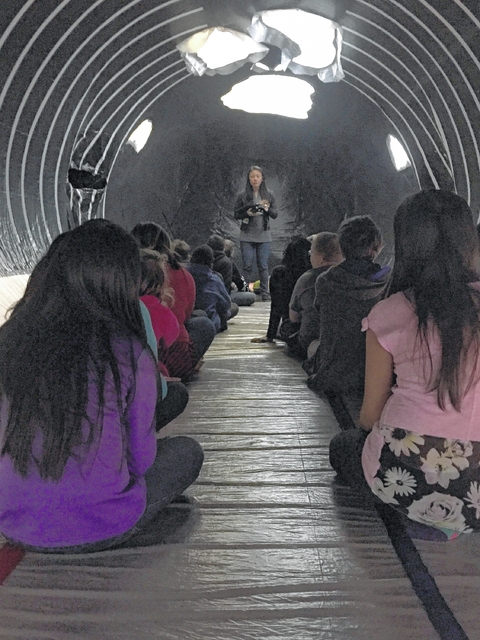Most fifth-grade students are unaware of the impact trash can have on marine life in the ocean. The fifth-grade students at Union Intermediate School had the chance earlier this week to learn about the detrimental impacts marine debris can have on migrating animals.
UIS media specialist Caren Long attended the University of North Carolina at Wilmington Center for Education Science, Technology, Engineering and Mathematics (CESTEM) annual conference earlier this year. While attending the conference, Long said she had the opportunity to visit with members of the UNCW Marine Department about the Traveling Through Trash outreach program that travels to different schools.
With the aid of grant money, Long and UIS were able to invite the UNCW team to the school, bringing a bit of the coast into the school.
“This was a wonderful learning experience for our students,” Long said. “We were lucky to get this grant and bring these guys into our school.”
According to Long, UNCW MarineQuest developed the coast-to-classroom program as a way to bring marine life to schools and offer children a chance to be engaged in the learning process.
“I learned about how if we don’t recycle or pick up after ourselves that we can’t enjoy the amazing animals,” Brianna Serrano said. “Even in you live an hour away, trash still ends up in the ocean. We as a community are hurting endangered animals like the North Atlantic Right Whale. We need to work together to help the animals because they are special just like us.”
As part of the learning program, the team brings a 56-foot inflatable whale classroom, where they conduct presentations and teach students about whales. When inflated, the life-size whale filled the UIS gymnasium.
The whale classroom holds up to 25 students, plus a teacher and the instructional staff. Inside the whale, the students share the space with life size organs, such as the heart, stomach, kidney, lungs and 150 feet of intestines. Often, students will notice something inside the whale’s intestines — thus the lesson begins.
“We conduct a simulated dissection and reveal that the whale had ingested a substantial amount of marine debris, mostly fishing line, plastic bottles and trash bags,” a member of the marine team said. “This leads to a discussion of how ingesting the debris might have impacted the whale. Kids even ask if that is what killed the whale, completely forgetting that they are sitting inside of what is essentially a very large plastic bag.”
Students in Marsha Tart’s science class were able to visit the exhibit Monday, and have a chance at learning about marine debris and how it affects animal life in the ocean.
“I learned that marine debris is trash that ends up in the ocean,” Canaan Murphy said. “Marine debris can kill baby turtles or the fish in the ocean. The whale I learned about is called the North Atlantic Right Whale. They are one of the largest whales in the world. Hopefully people can make sure no more trash gets into the ocean.”
For fifth-grade student Catalina Nery, learning about the negative effects of marine debris, she learned that the ocean can be damaged in the process.
“While learning about marine debris, I learned that because of it, mammals and many different things in the ocean can be affected and can be damaged,” Nery said. “I also learned about a mammal that is endangered and it’s called the North Atlantic Right Whale.”
As the science teacher, Tart said the whale exhibit from UNCW was a wonderful experience and asset to her fifth-grade students.
“Earlier this year, UIS students learned about ecosystems, both terrestrial and aquatic. As part of this exhibit, students learned how pollution from humans has a negative impact on marine environments as well as the organisms that populate them,” Tart said.
According to Tart, this particular activity brought in the previously learned “runoff” and “collection” parts of the water cycle and students had to recall that all water that falls on land, through streams and rivers, eventually ends up in the ocean.
“The highlight of the exhibit for the students was when they learned they were considered a coastal community because they live within 100 miles of the coastline, and they were able to crawl inside the whale and learn about how pollution can harm animals, possibly to the point of extinction,” Tart added. “This learning opportunity with UNCW was a great way to review several previously learned science concepts, and it will also correlate very nicely with the students’ upcoming Scrap Exchange activity in which they will learn how all kinds of “trash” can be used to create various items of use.”

